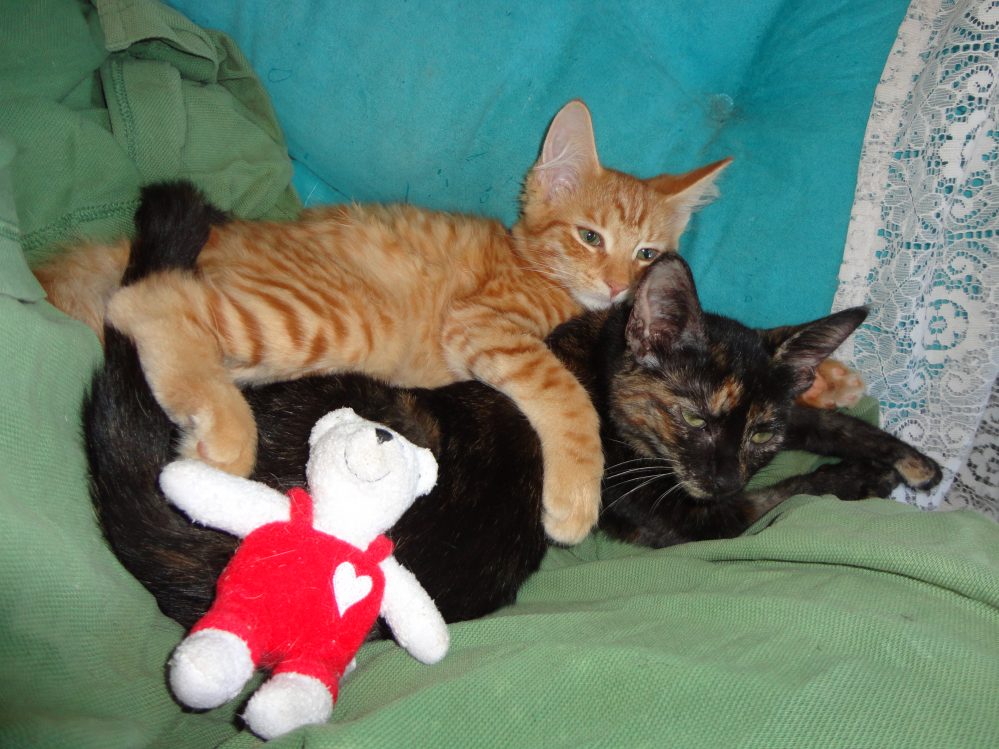Perhaps they are not old. So lets just say “current cats”
Since we have a lot of new cats come trough our house on the way to new homes our current cats are accustomed to seeing new faces and usually welcome there new guests.
But sometimes the guest cats are not crazy about suddenly being uprooted and arriving in a new pad even though it’s tastefully decorated.
First congratulations on your new family member.
Now, set up a separate room as a home base for your new cat and spend as much time as you can with the new guy. This in house separation will allow for a gradual introduction to the current family.
For the first 72 hours, do nothing. It is important to allow your new cat to become accustomed to her surroundings. Your new cat is not only acclimating to home base, she also is using her fine-tuned senses to discover what is beyond the closed door, including current cats. After 72 hours, begin introducing the cats to each others’ scents. First, leave a blanket, towel or cat bed in the home base for the new cat and another on your current cat’s favorite sleeping spot.
After they each have spent time sleeping on the bedding, exchange them. This scent introduction will help your cats get used to each other and will help improve the eventual face-to face, whiskers to whiskers meeting.
While the cats are becoming used to each others’ scents, create positive experiences for them while they are still safely separated. Feed the cats on either side of the closed home base door. Get a feather toy and encourage play under the door. By creating positive experiences, you send the message that another cat is a good, fun friend to have in the house.
After a week of letting the new kitty acclimate to home base, it is time for the old switheroo. Switch the cats’ living areas. Let your new cat explore the rest of the house while your current cat stays in home base. Be sure to not let the cats meet while you are swapping rooms. After a few hours of exploration, you can return the cats to their original spaces. After about a week or two, (see if you feel one week is enough) it is time to start introducing the cats. Trim both cats’ nails (everyone loves a good manicure) to lessen the chance of injury. If you’ve never done it look up online. There are many good step by step videos. Place a plate of wet food or some fresh deli meat outside of the home base door and place another treat down the hall from the door, but still in sight of home base. Lure your current cat to the treat down the hall, and while she is enjoying the treat, open the door to home base and allow the new cat to enjoy her treat. By allowing the cats to see each other while enjoying some good food, it will help them associate rewards with the other cat. After they have finished their treat, place the new cat back in her room. The next day, repeat the above step, but this time place the plates a couple of feet closer together. Continue this process until the cats get close enough to meet face-to-face.
It is important not to interfere when they meet. It is normal for cats to hiss, howl, posture, and swat when they first meet. So don’t freak out. In the unlikely event that they do begin to fight, do not pick up either cat. You will probably get scratched (hence the manicure). Put a towel or blanket between them to block their view of each other and try to corral one to a safe place. You may need to spend more time creating positive experiences before introducing them face-to-face again. After the cats have spent time together without conflict, gradually increase the amount of time the cats are out together. After they have spent several hours harmoniously sharing the same territory, several times in a row, you can leave them alone together. Or you may get lucky and they will get along swimmingly right off the bat.
Be patient as the process of introducing cats can take time, but in most cases, cats will learn to coexist peacefully. And in many cases, cats can become life-long friends.

